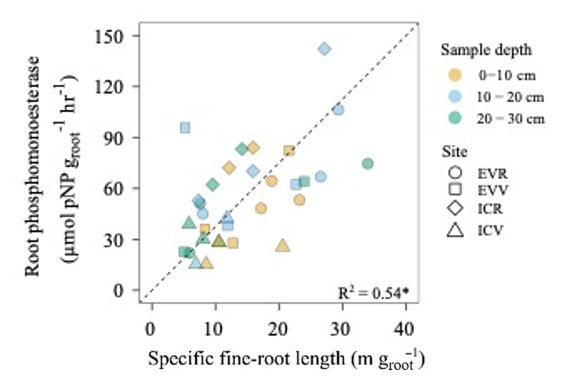The Science
In tropical forests available phosphorus can limit plant growth. Enzymes released by plant roots and soil microbes can increase phosphorus availability throughout the soil profile. Phosphatase enzymes convert phosphorus bound in organic molecules to an inorganic form that is available to plants. Roots of different tree species can have different effects on phosphatase activity. The amount of roots and their activities vary with depth in soil. Current models distribute roots through the soil column; new data on how root traits, soil characteristics, and phosphorus availability vary with soil depth will improve how models represent tree growth in tropical forests.
The Impact
This study pairs new data on soil and root phosphatase with fine-root and soil factors. The root and soil factors regulate enzyme activity in the soil profile. The results improve our understanding of root-soil interactions that influence phosphorus dynamics. These findings from a tropical forest in Puerto Rico generated predictive relationships that were robust across a wide range of soil conditions. The best equation predicted root phosphatase from specific root length and soil available phosphorus content. These relationships will enable more accurate models of phosphorus control on tropical forest productivity under changing environmental conditions.
Summary
Our objective was to determine fine-root traits and soil measurements that influenced soil and root phosphatase activity in the soil profile. We measured soil and root phosphatase to 1 m and 30 cm in soil depth respectively, including corresponding soil conditions (phosphorus concentrations, soil texture, bulk density) and fine-root traits (specific root length and fine-root mass density). We found that soil phosphatase can be predicted by bulk density, organic phosphorus, and fine-root mass density and that variation in root phosphatase can be explained by available phosphorus and specific fine-root length. Thus, both fine-root traits and soil phosphorus measurements are needed to understand mechanisms, like phosphatase, that mediate phosphorus availability in tropical forests. These findings strengthen the link between phosphatase activity and existing root and soil phosphorus parameters in ecosystem models enabling a more accurate representing of the phosphorus cycle. Our data merge phosphatase activity —a root and microbial function important to phosphorus acquisition— with fine-root traits and soil data, informing our understanding of phosphorus acquisition throughout the soil profile and the potential feedbacks to tropical forest growth.


Contact: BER Program Manager, Daniel Stover, U.S. Department of Energy Office of Science, Office of Biological and Environmental Research, Earth and Environmental Systems Sciences Division (SC-33.1), Environmental System Science daniel.stover@science.doe.gov
Brian Benscoter, U.S. Department of Energy Office of Science, Office of Biological and Environmental Research, Earth and Environmental Systems Sciences Division (SC-33.1), Environmental System Science, brian.benscoter@science.doe.gov
Principal Investigator: Richard J. Norby, Oak Ridge National Laboratory, currently, University of Tennessee, Knoxville rnorby@utk.edu
Kristine G. Cabugao, Lawrence Berkeley National Laboratory, KCabugao@lbl.gov
Funding
This research was supported as part of the Next Generation Ecosystem Experiments‐Tropics, funded by the U.S. Department of Energy, Office of Science, Office of Biological and Environmental Research.
Publications
G. Cabugao, et al., “Bringing function to structure: Root-soil interactions shaping phosphatase activity throughout a soil profile in Puerto Rico.” Ecology and Evolution 11, 1150-1164 (2021). [DOI: 10.1002/ece3.7036]
Norby, K. G. Cabugao, D. Yaffar.“Root-soil depth profile in Luquillo Experimental Forest, Puerto Rico, February, 2019”. NGEE Tropics Data Collection. (dataset). [DOI: 10.15486/ngt/1574087]